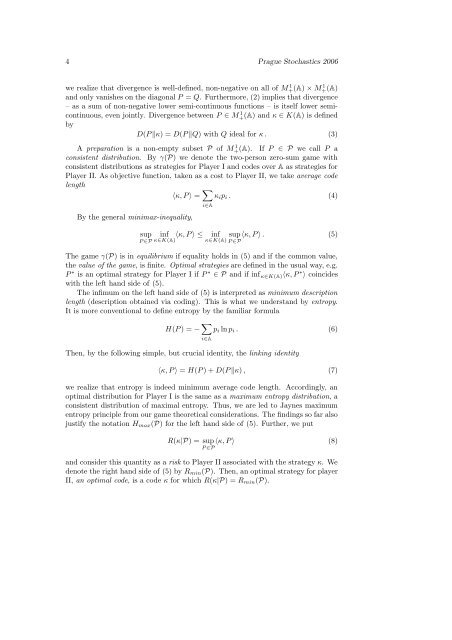Between Truth and Description
Between Truth and Description
Between Truth and Description
You also want an ePaper? Increase the reach of your titles
YUMPU automatically turns print PDFs into web optimized ePapers that Google loves.
4 Prague Stochastics 2006<br />
we realize that divergence is well-defined, non-negative on all of M 1 + (A) × M 1 + (A)<br />
<strong>and</strong> only vanishes on the diagonal P = Q. Furthermore, (2) implies that divergence<br />
– as a sum of non-negative lower semi-continuous functions – is itself lower semicontinuous,<br />
even jointly. Divergence between P ∈ M 1 + (A) <strong>and</strong> κ ∈ K(A) is defined<br />
by<br />
D(P �κ) = D(P �Q) with Q ideal for κ . (3)<br />
A preparation is a non-empty subset P of M 1 +(A). If P ∈ P we call P a<br />
consistent distribution. By γ(P) we denote the two-person zero-sum game with<br />
consistent distributions as strategies for Player I <strong>and</strong> codes over A as strategies for<br />
Player II. As objective function, taken as a cost to Player II, we take average code<br />
length<br />
〈κ, P 〉 = �<br />
κipi . (4)<br />
By the general minimax-inequality,<br />
sup<br />
inf<br />
P ∈P κ∈K(A)<br />
i∈A<br />
〈κ, P 〉 ≤ inf<br />
κ∈K(A) sup 〈κ, P 〉 . (5)<br />
The game γ(P) is in equilibrium if equality holds in (5) <strong>and</strong> if the common value,<br />
the value of the game, is finite. Optimal strategies are defined in the usual way, e.g.<br />
P ∗ is an optimal strategy for Player I if P ∗ ∈ P <strong>and</strong> if inf κ∈K(A)〈κ, P ∗ 〉 coincides<br />
with the left h<strong>and</strong> side of (5).<br />
The infimum on the left h<strong>and</strong> side of (5) is interpreted as minimum description<br />
length (description obtained via coding). This is what we underst<strong>and</strong> by entropy.<br />
It is more conventional to define entropy by the familiar formula<br />
P ∈P<br />
H(P ) = − �<br />
pi ln pi . (6)<br />
Then, by the following simple, but crucial identity, the linking identity<br />
i∈A<br />
〈κ, P 〉 = H(P ) + D(P �κ) , (7)<br />
we realize that entropy is indeed minimum average code length. Accordingly, an<br />
optimal distribution for Player I is the same as a maximum entropy distribution, a<br />
consistent distribution of maximal entropy. Thus, we are led to Jaynes maximum<br />
entropy principle from our game theoretical considerations. The findings so far also<br />
justify the notation Hmax(P) for the left h<strong>and</strong> side of (5). Further, we put<br />
R(κ|P) = sup 〈κ, P 〉 (8)<br />
P ∈P<br />
<strong>and</strong> consider this quantity as a risk to Player II associated with the strategy κ. We<br />
denote the right h<strong>and</strong> side of (5) by Rmin(P). Then, an optimal strategy for player<br />
II, an optimal code, is a code κ for which R(κ|P) = Rmin(P).

















